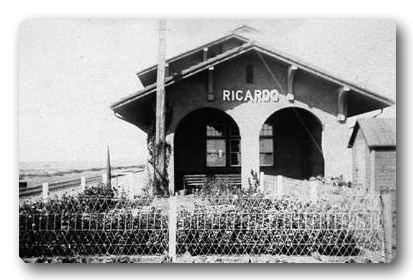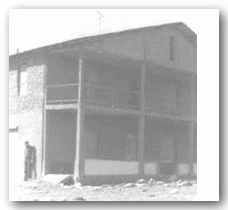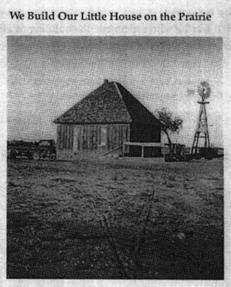Ricardo
Ricardo is in De Baca County five miles south of US 60 on the AT&SF RR,
ten miles SW of Ft. Sumner, NM. Post office 1908 – 54.
 |
AT&SF Depot at Ricardo, NM. Picture taken ca. 1912. Photo furnished by Ray Thompson. |
The following story is used here with permission from Ray Thompson. This was the
Madison Todd family and they are listed in Ricardo, NM in the 1910 Federal Census.
It is placed here as a first hand account of early life in Ricardo, New Mexico. It is to
be used only for home Genealogical research and is not to be reproduced in any form
for profit without written permission From Ray Thompson.
Copyright © 1989 by Ray Thompson
The following pages contain excerpts from the book,
“Our Little House on the Prairie”
by
Zorene (Todd) Thompson
This book is an account of life on a homestead near Ricardo, New Mexico Territory, in the early years of the 20th century. It was published by Zorene’s son, Ray Mack Thompson in 1989. Zorene is now deceased, but Ray is currently planning to republish her book and solicits any information about the people and life in Ricardo. These excerpts are being provided to parties who have provided such information.
Ray M. Thompson
raymack@mac.com
http://www.raymack.com
https://www.facebook.com/groups/823443521078994/?ref=group_header
UPDATE - July 2018
Dear DeBaca Researchers,
The following stories are from my mother Zorene’s book, “Our Little House
On the Prairie,” which she wrote in 1983, at the age of 84. The posting
here has helped me make contact with others who lived and worked in and
around Ricardo in the early years of the 20th century.
I’m pleased to announce that I have republished mother’s book, with
additional notes and comments from my contacts and research about the
period. The 2nd Edition of “Little House On the Prairie” is, first of
all just a family history, but I am glad to share it with anyone
interested in the history of New Mexico, DeBaca County, Ft. Sumner, and
Ricardo.
Please e-mail me for a pdf copy (110 pages).
Thanks!
Ray Mack Thompson
raymack@mac.com
http://www.raymack.com
Chapter 1
I was born, January 28, 1901, in East Texas.
Chapter 2
We Move to New Mexico
On June 2, 1907, my Grandmother, Mattie White Todd, died. Lon Todd, her second son who was living in El Paso, came for the funeral and a visit. While in our home he persuaded Madison, my father, to return home with him, to investigate the possibility of our moving to a drier climate. They had a second cousin, Dr. Reynolds, who lived and practiced in La Lande, New Mexico, 6 miles east of Ft. Sumner; he and the Todd boys had been childhood playmates. On a previous visit to East Texas, he had advised my father to investigate the possibility of moving to this area of New Mexco, where he thought the dry climate would improve his health.
Finally Madison found what he wanted… the homestead he chose was three-quarters of a mile south of the railway station at Ricardo, New Mexico.
Madison went out first, in an “emigrant car”. Accompanied by two of his life-long friends and cousins (from the Phillips family). As I remember, the emigrant car was just an ordinary box car loaded with our belongings in one end and our animals in the other. The passengers rode in the same car with their freight, so they could tend to their stock. In addition to our personal possessions, furniture, and farm equipment, a specal part of the load was a barrel of ribbon cane syrum. My father had the reputation of being the best “syrup maker” in Upshur County, and this barrel of syrup was enjoyed to the very last drop!
My father’s sister, Mary Todd, decided to “move west” with us, and accompanied my mother, Judson, and I on the train as soon as father wrote that our living quarters were ready. We boarded the regular passenger train in Gladewater, Texas in late Summer, 1908.
Mother, Judson, fathers sister Mary and I, finally reached Farwell, Texas on the Texas/New Mexico border, and right across the line from Texico, New Mexico. For the life of me, I can’t remember if we spent the night in Farwell or Texico, but I do remember that it was my first time to spend the night in a hotel.
Ricardo
I think it was the middle of the afternoon before we reached our destination and saw Ricardo for the first time. Madison was there in a wagon to greet us! The depot was a lovely building…exactly the same as all the others that the Santa Fe Railway built along their line, every 14 miles! Part of the depot was two storied, with what passed then for luxurious living quarters for the railway agent and his family.
 |
 |
When we arrived in Ricardo in 1908 it had a post office, blacksmith shop, hotel (of sorts), a nice general merchandise store, a barbershop and probably a few more establishments that I don’t remember. I do remember that there were four or five saloons…something we kids had not seen before. In the center of the town a well had been drilled and equipped with a windmill, trough for stock to drink, and an elevated tank for a water supply. There were also a few residences in town, but no school.
Our Homestead
The first homes built by many of the homesteaders were earthen “dug-outs” built at least partially under ground. Some of them had one or two rooms of lumber built above the under ground cellar. Some one (probably our doctor) advised our father that his health might improve faster if we lived in tents, and this is what Madison erected for our first home. We had two tents, quite a large one for our living quarters, and a smaller one for the kitchen. These were stretched over a framework of wood which included a plank floor, walls about five feet high and open rafters.
Stickers!
As soon as we reached our tent home, Judson and I were ready to get outside and play,.. Since we were used to going bare-footed in East Texas, mother told us we could take off our shoes and stockings. The next thing we knew our feet were full of stickers… the worst we had ever seen! When we sat down to try to pull them out we got them into our bottoms, legs, and everything we let touch the ground. Our loud cries soon brought mother and Aunt Mary, and then father. He scolded mother for letting us take off our shoes, while explaining that in clearing off space for out tents they had raked the prickly pear cactus into the soil and that it was no place for children to play without shoes! Judson and I were in a sad predicament, and had to lie “face down” while our parents pulled out all the stickers! I DO NOT LIKE CACTUS!
No “Witchers” Need Apply!
The second major phase in establishing our new home (after father put up our tents) was having a well drilled, I remember hearing a neighbor say we would need a professional “water witcher” to use his “divining rod” to locate the spot where water would be found. I also remember my father’s reply, “I will do no such thing! I know where I want my well, and that’s where it will be drilled.” Sure enough the drillers did find water in that spot! The well then had to be “cased”, and the wind-mill tower erected. In the meantime, water was brought up to the surface with a bucket and rope on a pulley. This was hard work and water conservation was a top priority. We had always had “soft” water in East Texas, but this water was “hard”, and it tasted awful! Until we were caught, Judson and I had fun with our hard water by making what looked like buttermilk in the wash basin using mother’s best home-made soap.
Snow On the Prairie
One incident happened that winter that I will always remember. I was awakened early one morning by mother’s excited voice and looked up to see the top of our tent sagging down, very low over our heads. Through the tent covered ridges we could see the sun shining, but the light inside our tent was different, and there was an eerie feeling in the air….I remember father jumping out of bed and rushing to the door. When he tried to open it, a great wall of snow fell inside the tent! Without any warning, a heavy snow had arrived during the night, but now the sun was shining as though it was mid summer! We were all in a hurry to get outside and see this new world! Father had a hard time getting out of the tent, because of all the snow that was pressing against the outside door. Sometime during the day, father shoveled the snow out so we could have paths to the well, the barn, the out-house, etc. This made the paths into little “canyons”, wide enough so that Judson and I could pull our little wagon. Amazingly, as the snow melted over the next few days the paths remained dry! I can still remember the fun Judson and I had playing through those canyons of snow, on dry land…. To this day that is the deepest snow I have ever experienced.
Spring wasn’t a good time for our tents, for the wind begin to blow…Day and night it blew and along the top of our wooden walls our tents began to split. Finally , we had to move into a rented shack and plans for a new house had to be made.
 Out of the blue (as far as I can remember), a survivor from the terrible San Francisco earth-quake appeared in our midst, claiming to be a building contractor. It was he who supervised the building of our new house. It turned out to be a rather large four-room house with a peculiar steep roof that caused it to become a curiosity in the area.
Out of the blue (as far as I can remember), a survivor from the terrible San Francisco earth-quake appeared in our midst, claiming to be a building contractor. It was he who supervised the building of our new house. It turned out to be a rather large four-room house with a peculiar steep roof that caused it to become a curiosity in the area.
Personally I could never understand why such a high roof was built. In fact, I had a suspicion that my folks were not too pleased but they never discussed it in my hearing.
Chapter 3
Early Days in Ricardo
Community Service
Our father was active in the community life of Ricardo. He was elected to serve on the first school board (he was almost 30 years old) and gave a lot of his time and effort to get a school house and other improvements for our
little town. He was the first Justice of the Peace for Ricardo. (I can't remember if he was elected or appointed.) I recall only a few events that required his official attention as a "JP".
I well recall the most tragic occasion for which father was called to serve as a "peace officer"… it began late in the day. Two men from Ricardo came to our homestead to tell father of a killing; father was needed to arrest the killer. One of father's friends (a young lawyer) had been shot and killed by the wife of the Agent for the Santa Fe Railway Company. The story was that the young lawyer and his girl friend had been hunting rabbits on the Agent's property. The Agent's wife saw them going into the field and became angry, because she thought some cows belonging to the lawyer's girl friend were also eating grain in the field. She followed them with a loaded gun, confronted them, and killed the young man instantly. We were disturbed (and yet terribly excited) that our father had to go arrest the killer. The plan was for father and two deputized friends to accompany the prisoner to Santa Rosa on the passenger train.
Mother worried when told that the group would have to spend the night in Vaughn, and go on to Santa Rosa the next day. However, as it turned out, Federal Officers (New Mexico was still a Federal Territory, not yet a state) met them in Vaughn and took charge of the prisoner, allowing our men folks to return to Ricardo the same night… much to our relief. Incidentally, the lady prisoner was judged to be insane, and was committed to an institution.
No one knew the address of any relatives of the young man who was killed. I remember that some years later, after we moved to Pecos, our parents received a letter of inquiry concerning him. While the letter or the reply was never discussed in my hearing, mother did tell us that they gave what information they could about his death… father's last duty as a Justice of the Peace for the New Mexico Territory!
Chapter 7
We Move Back to Texas
Our Cemetery
When we lived in Ricardo we had no funeral home. When a death occurred, neighbors made the casket and did all the necessary things for burial, including a prompt grave-side ceremony. At first we did not even have a cemetery, but our father deeded a plot of land on the southeast corner of our claim for this purpose. Father's young lawyer friend was the first burial in the new cemetery, but when we left Ricardo there were three graves, all marked by home-made wooden markers, and all personal friends of our family… a sad spot on our "Lonesome Prairie". (See map in chapter 2.)
Since moving to Carlsbad, in 1978, I have been able to visit several times with my former Ricardo school teacher, Mrs. Jean (Davis) Stearns (she will always be Miss Jennie, to me). On one visit we tried again to drive to our old homestead, but found that the site had long since been enclosed inside a large fenced lease and posted against trespassers.
On another visit ( 1980, I believe), accompanied by Barbara and a mutual Carlsbad friend, Christine Bowers, we decided to try and visit the old Ricardo cemetery. Accompanied by Miss Jennie, we enlisted the help of some of her friends. The friends lived in a large ranch home between Ft. Sumner and Ricardo. The rancher friend was very sympathetic, but quickly told us that there was no way we could drive to the cemetery by ourselves in my '74 Buick!. However, his son was home from vacation (from Texas A&M, by the way… Judson's Alma Mater), and the father
volunteered him to take us to the cemetery in their pickup. Barbara and Miss Jennie elected to stay at the ranch house, but Christine and I climbed into the young man's pickup and off we went!
We had a very enjoyable visit with the young rancher, as he drove us over a very bumpy and dimly defined road to the old cemetery. When we arrived, I was glad to see that it was enclosed by a nice wire fence and that the wide gate was well marked, "Ricardo Cemetery". Our young driver helped us from the truck, opened the heavy gate, and told us to take our time looking around. There were a large number of graves, most of them well marked. I was able to locate the three oldest graves, just as I remembered them, except they were now marked by durable granite headstones…
I will always remember this trip in a special way… the surprising vitality of Miss Jennie in her 90-plus years, and the kindness of the rancher and his son. That's the way I remember all the people from my early days in Ricardo.
END OF EXCERPTS
(The young lawyer who was killed was BRUSNAHAN, C. Frank, Mar. 21, 1884 - Sept. 27, 1912)
USGENWEB NOTICE: In keeping with our policy of providing free information on the Internet, data may be used by non-commercial entities, as long as this message remains on all copied material. These electronic pages may NOT be reproduced in any format for profit or for presentation by other persons or organizations. Persons or organizations desiring to use this material for purposes other than stated above must obtain the written consent of the High Plains Historical FD. Inc.

